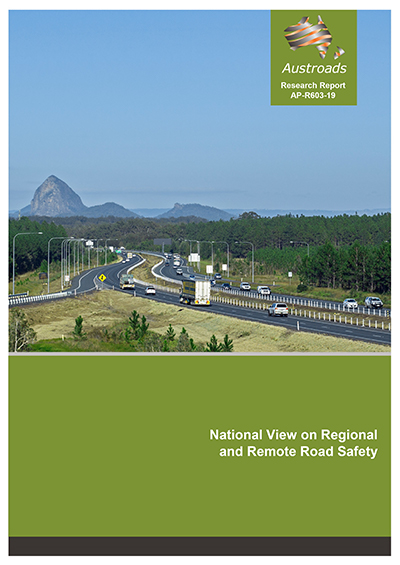Road Safety

- Publication no: AP-R603-19
- ISBN: 978-1-925854-36-7
- Published: 4 September 2019
- PDF (free) Download
Road crash fatality rates continue to be unacceptably higher in regional and remote areas than major cities. This report provides a comprehensive investigation of the causes of road crashes in regional and remote Australia and gives strategic guidance to identify the best approaches to eliminate harm on the road network in these areas.
The research suggests that, consistent with the Safe System approach, long term strategic perspectives are important, and jurisdictions should use network safety plans to determine how to allocate resources. Systemic change is integral and treatment options should support corridor safety plans that incorporate solutions beyond infrastructure alone and facilitate enforcement, quality rest stops, and alternative transport options. Other key Safe Systems solutions that show promise in regional and remote areas are: vehicle based speed management technologies and fleet speed/fatigue management policies; incentives and policies to accelerate proven safety and driver assist technologies into the driving fleet; alternative community transport services; and community led programs in remote areas that improve access to licensing and fit child restraints.
The report concludes with a series of recommendations and areas for further research that provide strategic directions and clear sustainable actions that are urgently needed to eliminate fatalities and serious injuries on regional and remote roads.
- Summary
- 1. Introduction
- 1.1 Regional and Remote Road Safety
- 1.2 Regional and Remote Areas: The Context
- 1.3 The Safe System Approach
- 1.4 The National Road Safety Strategy 2011-2020
- 1.5 Scope of Project
- 1.6 Report Outline
- 2. Overview of Regional and Remote Road Trauma
- 2.1 Defining Regional and Remote Areas
- 2.2 NRSS Safety Performance Indicators by Remoteness
- 2.3 Crashes on Regional and Remote Roads
- 2.4 Casualties on Regional and Remote Roads
- 2.5 Summary of Findings
- 3. Consultation with Stakeholders
- 3.1 What are the Key Road Safety Issues in Regional and Remote Areas?
- 3.2 What are the Key Road Safety Issues for Aboriginal People?
- 3.3 Do you Think There is Sufficient Data Being Collected to Monitor These Issues in Your Jurisdiction?
- 3.4 What Initiatives Would You Like to See to Improve Regional and Remote Road Safety?
- 3.5 Who are the Key Road Safety Partners to Assist in Improving Regional and Remote Road Safety?
- 3.6 Which Regional and Remote Road Safety Issues, if any, Do You Think Need to be Addressed at a National Level? What are the Barriers to Addressing These Issues?
- 3.7 Do you Think There Should be a National Regional and Remote Road Safety Strategy?
- 3.8 What do You Think it Would Take to Eliminate Road Trauma in Regional and Remote Areas?
- 3.9 Summary of Findings
- 4. Literature Review: Regional and Remote Road Safety Issues and Countermeasures
- 4.1 Methodology
- 4.2 Safe Roads
- 4.2.1 Australia’s road network
- 4.2.2 Road condition
- 4.2.3 Road design
- 4.2.4 Roadside environment
- 4.2.5 Countermeasures: Improved road design and infrastructure
- 4.3 Safe Vehicles
- 4.3.1 Vehicle age and safety
- 4.3.2 Countermeasures: Safe vehicle technologies, promotion of safer vehicles and fleet purchasing policies
- 4.4 Safe Speeds
- 4.4.1 Speed limits
- 4.4.2 Countermeasures: Speed management
- 4.5 Safe People
- 4.5.1 Alcohol
- 4.5.2 Countermeasures for drink driving
- 4.5.3 Illicit drugs
- 4.5.4 Countermeasures for illicit drug driving
- 4.5.5 Fatigue
- 4.5.6 Countermeasures for fatigue
- 4.5.7 Unlicensed driving
- 4.5.8 Countermeasures for unlicensed driving
- 4.5.9 Seat belt and child restraint use
- 4.5.10 Countermeasures to promote seat belt and child restraint use
- 4.5.11 At-risk populations
- 4.5.12 Countermeasures: At-risk populations
- 4.5.13 Post-crash response
- 4.5.14 Countermeasures targeting post-crash response and trauma management
- 5. Responses to NRSS
- 5.1 Background: Regional and Remote Road Safety in the NRSS
- 5.2 Safe Roads
- 5.2.1 NRSS directions
- 5.2.2 Responses to NRSS
- 5.3 Safe Vehicles
- 5.3.1 NRSS directions
- 5.3.2 Responses to NRSS
- 5.4 Safe Speeds
- 5.4.1 NRSS directions
- 5.4.2 Responses to NRSS
- 5.5 Safe People
- 5.5.1 NRSS directions
- 5.5.2 Responses to NRSS
- 6. Summary of Findings
- 6.1 Current Issues to Address in Regional and Remote Areas
- 6.2 Safe System Countermeasures for Regional and Remote Areas
- 6.3 Effective Planning for a Safe System on the Regional and Remote Road Network
- 7. Conclusions and Recommendations
- 7.1 Safe System Solutions for Regional and Remote Australia
- 7.1.1 Safe people
- 7.1.2 Safe roads
- 7.1.3 Safe speeds
- 7.1.4 Safe vehicles
- 7.1.5 Partnerships, innovation, ownership
- 7.1.6 Governance and resources
- 7.1.7 National regional and remote road safety strategy actions
- 7.1.8 Regional and remote data issues
- 7.2 Further Research to Improve Regional and Remote Road Safety
- References
- Appendix A Fatal Crash Data Tables
- Appendix B Questions for Consultation with Stakeholders
- Appendix C Stakeholders
- Appendix D Safe System Countermeasures Tables
